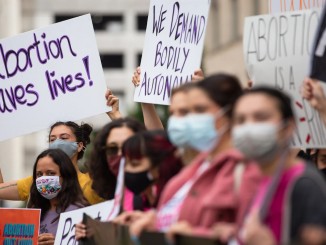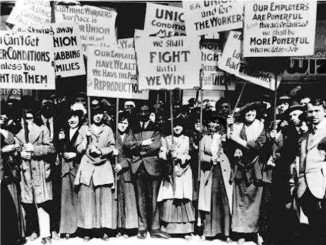Women’s rights in society, from the right to vote to the right to legal abortion, were all fought for and won by women themselves. More than in any other period, the 1970s saw a mass movement of women, inspired by the example of the civil rights and black power movements of the 1960s, pushing back against the oppression in this society.
Before the 1960s, the U.S. was a deeply unequal society. Most of society believed women belonged in the home, as full-time housewives, raising children, obediently serving their husbands. Divorce was seen as shameful, something to be avoided at all costs. Birth control and abortion were never to be discussed. Working women were looked upon as selfish, not concerned about their family. The average income of a working woman was one third of a working man. Almost half of women with school-age children worked while only two percent had access to preschools. For working women, housework never disappeared but became a second unpaid shift that now had to be performed after a tiring day at work.
The civil rights movement transformed this situation. Women were the backbone of the movement, playing an important role in organizing the massive movement against racism, which shook the foundations of the U.S. in the 1960s. While women were important organizers, they were kept in the background just as they were in the rest of society. The spokesmen of the civil rights movement were men, selected as much by the media as by the movement itself.
But women began to raise their voices and make their own demands. By 1967, protests were organized by women veterans of the civil rights movement, pushing for equality under the law. The women’s movement emerged as a national movement. The main leaders were mostly middle class women protesting for equality before the law. But poor and working women also took part in the movement, demanding not just freedom, but access to resources such as childcare.
The women’s movement, like the civil rights movement, tore down the legal barriers to equality through mass protests. Institutions from same-sex schools, to the armed forces, to NASA, and the Supreme Court were all integrated by gender. Pay discrimination was made illegal under state and federal law. However the most important issue taken up by the growing women’s movement was the fight for legalized abortion. Abortion was illegal, and most women, especially poor women, had to risk illegal and dangerous operations if they needed to have an abortion. Tens of thousands of women were injured or killed in these illegal abortions.
The women’s movement formed organizations such as the National Organization of Women, which waged national campaigns against state and federal anti-abortion laws. In 1973, in Roe v. Wade, the Supreme Court ruled that a woman had a right to decide whether or not to have an abortion.
While women were fighting for legal rights and equality, they formed discussion circles to talk about their experiences, examining every abuse of society. This transformed the culture, questioning everything from the portrayal of women in popular culture, to the language we use, the assumptions we make, and the attitudes we express. Sexism cannot be expressed as openly as it was before the women’s movement.
Hundreds of thousands of women participated in this movement in many different ways, and were able to permanently transform American culture. But as the movement subsided many of the same issues of inequality, reproductive rights, childcare, and ongoing violence against women have only worsened. The need for women’s liberation has not gone away, and the return of social movements in the future will lead women to once again take up the struggle to meet their needs, and fight for a complete liberation, one that struggles for a total social transformation, putting an end to the exploitation of all people, women and men.




